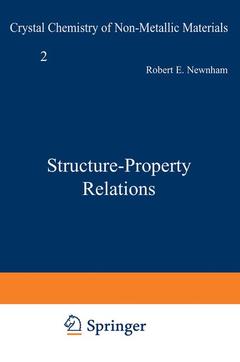Description
Structure-Property Relations, Softcover reprint of the original 1st ed. 1975
Coll. Crystal Chemistry of Non-Metallic Materials, Vol. 2
Author: Newnham R. E.
Language: French
Subject for Structure-Property Relations:
Keywords
Kristall; Nichtmetall; Structure; crystallography; materials; metal
Publication date: 07-2012
236 p. · 15.2x22.9 cm · Paperback
236 p. · 15.2x22.9 cm · Paperback
Description
/li>Contents
/li>
As a boy I loved to build model airplanes, not the snap-together plastic models of today, but the old-fashioned Spads and Sopwith Camels made of balsa wood and tissue paper. I dreamed of EDDIE RICKENBACKER and dogfights with the Red Baron as I sat there sniffing airplane glue. Mother thought I would never grow up to make an honest living, and mothers are never wrong. Thirty years later I sit in a research laboratory surrounded by crystal models and dream of what it would be like to be 1 A tall, to rearrange atoms with pick and shovel, and make funny things happen inside. Professor VON HIPPEL calls it "Molecular Engineering," the building of materials and devices to order: We begin to design materials with prescribed properties, to under stand the molecular causes of their failings, to build into them safe guards against such failure, and to arrive at true yardsticks of ultimate performance. No longer shackled to presently available materials, we are free to dream and find answers to unprecedented challenges. It is this revolutionary situation which makes scientists and engineers true allies in a great adventure of the human mind [1]. This book is about structure-property relationships, more especially applications of crystal chemistry to engineering problems. Faced with the task of finding new materials, the crystallographer uses ionic radii, crystal fields, anisotropic atomic groupings, and symmetry arguments as criteria in the materials selection process.
I. Symmetry and Crystal Physics.- 1. Crystal Classes.- 2. Space Groups.- 3. Symmetry Distribution of Crystals.- 4. Bond Length Calculations.- 5. Density.- 6. Physical Properties.- 7. Symmetry of Physical Properties.- 8. Tensors.- 9. Magnetic Symmetry.- References for Chapter I.- II. Electronic Transport in Materials.- 1. Atomic Orbitals, Molecular Orbitals, and Energy Bands.- 2. Electronic Materials.- 3. Semiconductors.- 4. Band Gap and Mobility.- 5. Semiconductor Doping.- 6. Semimetals and Narrow Gap Semiconductors.- 7. Magnetic Semiconductors.- 8. Molecular Circuits.- 9. Metal-Metal Bonding.- 10. Anisotropic Conductors.- 11. Superconductivity.- References for Chapter II.- III. Thermal Properties and Ion Transport.- 1. Lattice Vibrations.- 2. Thermal Properties.- 3. Thermal Conductivity.- 4. Ultrasonic Attenuation.- 5. Thermal Expansion.- 6. Diffusion.- 7. Ionic Conductivity.- 8. Ionic Switches.- 9. Superionic Conductors.- 10. Solid State Battery Materials.- 11. Photographic Process.- 12. Thermoelectric Materials.- 13. Thermionic Materials.- References for Chapter III.- IV. Ferroelectrics and Other Ferroic Materials.- 1. Polar Crystals and Pyroelectricity.- 2. Piezoelectricity.- 3. Acoustoelectric Effect.- 4. Ferroelectricity.- 5. Hydrogen-Bonded Ferroelectrics.- 6. Classification of Ferroelectrics.- 7. Transition-Temperature and Coercive Field.- 8. Ferroic Crystals.- 9. Free Energy Formulation.- 10. Primary Ferroic Minerals.- 11. Secondary Ferroics.- 12. Ferroic Symmetry Species Ill.- References for Chapter IV.- V. Optical Materials.- 1. Luster.- 2. Birefringence and Crystal Structure.- 3. Optical Windows.- 4. Color.- 5. Crystalline Lasers.- 6. Semiconductor Lamps.- 7. Luminescence.- 8. Cathodochromic and Photochromic Materials.- 9. Optical Activity.- 10. Photoelasticity.- 11. Nonlinear Optical Materials.- References for Chapter V.- VI. Magnetic Materials.- 1. Diamagnetism.- 2. Transition-Metal Atoms.- 3. Crystal Field Theory.- 4. Paramagnetic Salts.- 5. Transition Temperatures.- 6. Magnetization.- 7. Crystalline Anisotropy.- 8. Hard and Soft Magnets.- 9. Bubble Memories.- 10. Microwave Garnets.- 11. Magnetooptic Materials.- 12. Magnetoelectricity.- References for Chapter VI.- VII. Materials with Useful Mechanical Properties.- 1. Elasticity.- 2. Mechanical Analog.- 3. Elastic Anisotropy.- 4. Pressure Dependence of the Elastic Stiffness.- 5. Temperature Dependence of the Elastic Stiffness.- 6. Temperature-Compensated Materials.- 7. Surface Wave Materials.- 8. Molecular Geometry and Molecular Flexibility.- 9. Hardness.- 10. Grinding and Polishing.- 11. Friction and Wear.- 12. Dislocations and Plastic Deformation.- 13. Hard Metals.- 14. Cleavage.- 15. Brittle Fracture.- 16. Toughness.- 17. Strengthening of Glass.- 18. Composite Materials.- References for Chapter VII.- Chemical Index.
© 2024 LAVOISIER S.A.S.

